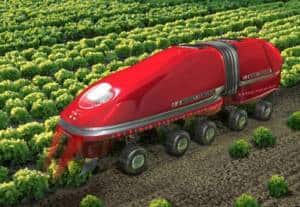Universities ploughing a distinctive furrow
Inspired by a recent piece on BBC Radio 4’s Farming Today, I thought I would remind myself of how many universities have farms. There are quite a few as it turns out. Universities need farms for research purposes but also use them for undergraduate teaching and postgraduate studies. Although they are not cheap to operate they are usually run as commercial farms too to enable at least some costs to be recouped.
I also liked this recent piece in the Guardian:
Agriculture is now the fastest growing subject at UK universities, with a 4.6% increase in student numbers last year, according to the environment minister Elizabeth Truss. There are now more than 19,000 people studying it and related subjects.
As a farming graduate, this sudden growth doesn’t surprise me. I studied at Harper Adams University (HAU), which specialises in agri-food and rural studies. In 2013-14, 96% of students who graduated from HAU and its associated collegeswere employed or in education six months after completing their course.
You may have thought a degree in agriculture is solely designed for farmers. But the degree is actually extremely diverse. Graduates who don’t go on to farms could be employed by food retailers and suppliers. They can go on to work in research and technology, consultancy, education, marketing or the media.
I’m not sure that this data is correct on the growth of the discipline but Agriculture and related subjects are key to national economic prosperity as well as tackling huge worldwide challenges around food security.
Here’s a selection of university farms then. All of them offer highly relevant courses and research:
 The University of Cambridge has a huge 1,085 hectares of farmland, both arable and livestock:
The University of Cambridge has a huge 1,085 hectares of farmland, both arable and livestock:
The arable area is approximately 1650 acres (668 hectares), comprising predominantly winter wheat, winter beans and a small area of winter barley. The remaining land is grassland which supports dairy, beef and sheep enterprises. The large-scale keeping of livestock in Cambridgeshire is unusual, but one of the obligations of the University Farm is to provide adequate teaching material for the Department of Veterinary Medicine. The Farm has a large number of relatively small, awkward-shaped fields which are totally unsuited to modern farming activities. The dairy unit was relocated to Park Farm, Madingley in 1997, to make way for development on the West Cambridge Site. Then, as a result of the North West Cambridge site, which will ultimately take approximately 300 acres (122 hectares) of land between Madingley Road, Huntingdon Road and the M11, all the remaining animal housing, grain stores and office space will also be relocated to Park Farm. In association with this move, the dairy unit has been refurbished so that the cows are now accommodated in cubicles and milked automatically by robotics.
The University of Nottingham farm has 445 hectares across three sites – arable and dairy (with robotic milking) and has also just been announced as the home for the new national centre for dairy research, the £27.7m national Centre of Innovation in Livestock (CIEL):
CIEL is a government funded initiative which aims to deliver world leading research in livestock health and production to deliver improved food security and farming sustainability.
The aim of CIEL is to provide a direct link between science and practice to enable the livestock sector to become more innovative and to take advantage of new technologies and cutting-edge research.
Novel facilities will be created at Nottingham, including a unique dairy unit, which will be equipped with a flexible interior to allow rearrangement of floors, bedding, loafing and feeding facilities.
The Dairy Health and Welfare Unit will be a state-of-the-art centre conducting research on interactions between factors such as the environment, breed, physiology and welfare.
The University of Reading has considerable land–based resources in the Reading area and boasts
some 760 ha of farmed land and woodlands at Arborfield, Shinfield and Sonning. In addition to the School’s substantial teaching and research resources in crops at Sonning and animals at Arborfield, the University Farms represent a significant commercial farming operation.
Meanwhile, the University of Liverpool has two farms in Cheshire:
Woodwork farm is a 200 acre dairy farm and Ness Heath is Liverpool’s all-grass, mixed-stock farm, covering 120 acres. Breeding stock on the farm comprises 450 February-lambing ewes, with pedigree herds of 24 Hereford cows and 16 Gloucester Old Spot sows.

Newcastle University also has two farms:
Nafferton Farm is a 300 hectares (ha) farm located 12 miles west of Newcastle upon Tyne, near Stocksfield in the Tyne Valley. It is rented from the Allendale Estate on a traditional AHA tenancy and constitutes the management and operational base of the Nafferton farming business, with the main farm steading located there.
Nafferton Farm has been tenanted by Newcastle University since July 1944. Farm activities presently include:
dairying
beef production
arable cropping
small-scale vegetable productionCockle Park is one of the few facilities in the UK that encompasses the farming of pigs, dairy, beef and sheep, as well as a variety of arable cropping and grassland trials. We are also a viable farming business, and our modern facilities are used daily by Newcastle University for teaching both undergraduate and postgraduate students from the Faculty of Science, Agriculture and Engineering.
A few others of note:
There are undoubtedly more in the UK. But here’s a handy list of some nice US university farms too.
One more institution to mention in this context is, of course, the not at all fictional Felpersham University made famous as the destination of many a character in everyone’s favourite farming saga, the Archers. You can find them here on Facebook and a list of Archers Academics here too.
University farms do yield great benefits therefore and perhaps deserve a little more recognition.













Rothampstead too. Although not a university in its own right it has huge acreage being farmed and a pile of PhD Studentships. http://www.rothamsted.ac.uk/
Scotland’s Rural College, Cirencester Agricultural University and UWE Bristol’s Associate Faculty at Hartpury might be feeling a little left out ? …and now get ready for Twitter to provide a list of every University farm in the world…